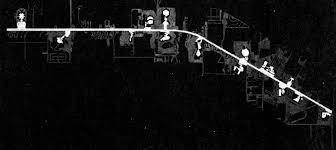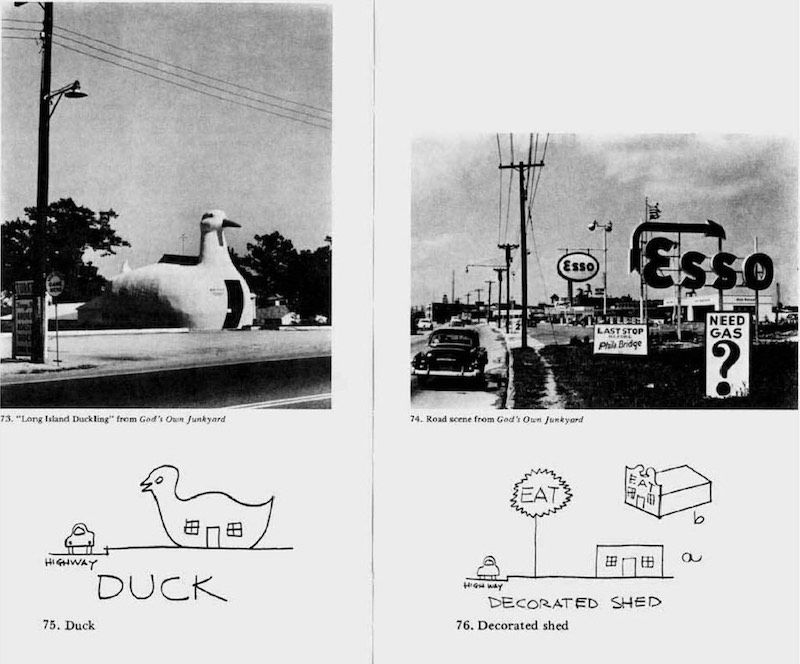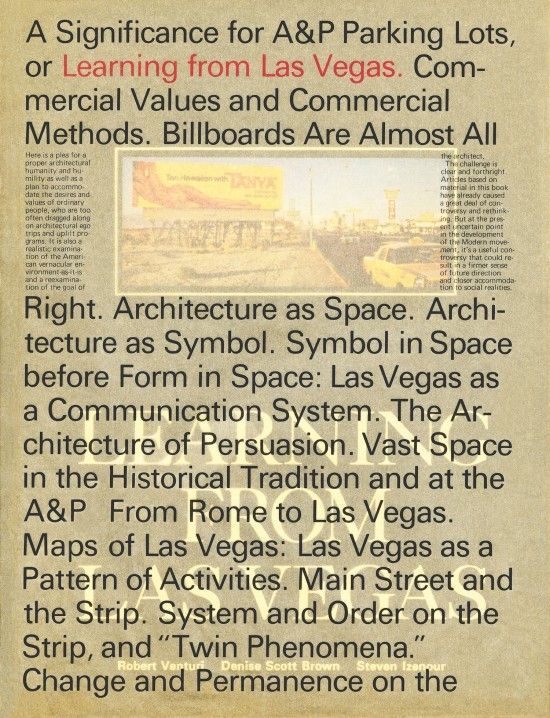Learning From Las Vegas Book Review and Notes
Introduction
Less is a Bore! -Robert Venturi
 Learning From Las Vegas by Robert Venturi, Denise Scott Brown, and Steven Izenour)
Learning From Las Vegas by Robert Venturi, Denise Scott Brown, and Steven Izenour)
Learning From Las Vegas (LFVLV) by Robert Venturi, Denise Scott Brown, and Steven Izenour is important for two reasons. It was a book that came, in 1972, at the end of late modernism. It proposed a radical break with the immediate past and also a reassessment and incorporation of more traditional forms of architecture back into current thinking.
It was also the book that launched the authors on that path and helped bring that thinking into the forefront of the Architectural debate for over twenty years. It helped launch the style Postmodernism and at first gave it a loose theoretical framework. So on these fronts it was amazingly successful. But that style has since fallen out of favour and ‘modernism’ has made a return.
Even today some fifty years later the book is still controversial. It can often be used as evidence on both sides of the style debate in any ongoing style war. It can at times feel more like a collection of writings rather than one single book.
There is an attitude to urban and architectural studies that covers the full gamut from high art to kitch and so it’s almost necessarily divisive. It contains iconic arguments; all buildings are either ducks or decorated sheds, and it exhaustively analyses a high-tide moment of Americana in the Las Vegas of the late 60s which doesn’t exist anymore at all. It supports the iconic but also the boring, the everyday.
If the Las Vegas strip is no longer at all the same as that in the book it dosen’t matter, we can see the muscle flex of rebellion in the book that is fascinating in itself. We can with some profit see again the arguments now they have played out in the world a little.
Denise Scott Brown and Robert Venturi

Denise Scott Brown
Denise Scott Brown after studying in London and then the U.S.A. joined the Architecture faculty of the University of Pennsylvania. She moved to UCLA and became interested in Los Angeles and Las Vegas and how those cities were developing.
Robert Venturi had worked for Eero Saarinen and then perhaps most formatively for Louis Kahn. Especially in his early work an echo of Kahn and his Pythagorean designs can be seen. He published Complexity and Contradiction in Architecture already in 1966 before LFLV.

Robert Venturi
Denise Scott Brown and Robert Venturi met as fellow faculty members at the University of Pennsylvania. They already understood each other as being outsiders from the mainstream in that they both were against demolishing the universities library the Fisher Fine Arts Library which is a kind of Venetian Gothic beaux arts revivalist cacophony. Their office VSB would later be responsible for restoring it.
When Denise Scott Brown moved to UCLA and became interested in Las Vegas, taking groups of her students there, she invited Venturi on one of these trips in 1966. Not long after they were married and Scott Brown had moved back to Philidelphia to join Ventirui Rauch, later Venturi Scott Brown (VSB).
The Book is also authored by Steven Izenour and much of the research made by Denise Scott Brown’s students. At the time the Architecture establishment was split between the ‘whites’ who were against the book and the ‘greys’ who were for.
The Form of the Book
Most people have and will experience the Book Learning From Las Vegas in the form of the Revised Edition which was first printed in 1977. This is very different from the First Edition (1972) which in form and contents differs. I have been reading a reprint of the Revised edition.
The first edition was a 14’ x 11’ full color extravaganza with three parts, the third covering the work of Venturi and Rauch. The Second edition scaled everything down including the illustrations and dropped the third part of the book covering Venturi and Rauch’s work. Another edition The Facsimile Edition from MIT press gives you the chance to purchase a version of the original first edition.
A good Discussion of this apparently can be found in Aron Vinegar’s book I Am a Monument(2008). But from this article in The Architectural Review it’s clear there is a meta discussion around the format and presentation of the book which is interesting in that it on some level echoes the book and its arguments. The presentation of architecture is the subject of the book and how the arguments and media were gathered and presented were contentious. It looks like they prefigured a much more collage type approach which we see for instance in the groundbreaking S,M,L,XL by Koolhaas and Bruce Mau.
Part 1 Learning From Las Vegas
Denise Scott Brown introduced Venturi to Las Vegas so this part of the book we can maybe associate more closely to her. But they seemed to have meeting of minds, certainly a kind of joint feeling they were battling against the received wisdom of the day, joint outsiders.

Driving down Las Vegas Boulevard in 1968– the seeds of modern day Vegas were already planted.
Image from Learning From Las Vegas (1972)
There is a certain amount of overlap between Part 1 and Part 2 but the first part is much more an analysis of the Las Vegas strip and the casinos. There is a lot of spatial and image analysis. Mapping of the strip including Nolli maps, analysis of shops, signage, types of space to name a few. Some comparisons between Las Vegas space and normal space.
I like this part of the book, fresh ground is being covered and perhaps some new insights can follow.
 Nolli map of the strip
Nolli map of the strip
General points from Part II
- “Autoscape” spacial relationships in the city “blown out” by the automobile Its urban space has no context to historical urban space.
- Las Vegas and Greek Daylight similarities.
- Las Vegas styles are cinematic and owe more to escape from reality.
- Virtualisation and Digitalisation of the urban realm, this might be one of the first times this has been clearly identified in a text.
- Architecture and city planning evolving more towards collage.
- Historical spaces are squat and high, modern spaces are deep and low.
we have swapped short high spaces for long low spaces. Talk about difference in monumentality between modern and pre modern worlds. -p.50
- ornamentation and denotative symbolism above spatial concerns.
Part 2 Ugly and Ordinary Architecture, or The Decorated Shed.
This part of the book is a collection of essays, and justification of their own work.

Big Duck, Long Island, USAPhotograph by Mike Peel (www.mikepeel.net).
Some Definitions Using The Comparative Method.
Starts with a proper explanation of the duck vs the decorated shed, and as a way to analyse buildings it has become famous. According to VSB there are two type of buildings, the ‘Duck’ or the ‘Decorated Shed’.
The Duck;
Where the architectural systems of space, structure, and program are submerged nd distorted by an overall symbolic form. This kind of building-becomingg-sculpture we call the duck in honour of the duck shaped drive-in, “The Long Island Duckling”
The Decorated Shed;
Where systems of space and structure are directly at the service of program, and ornament is applied independently of them. This we call the decorated shed
There is a continuation of the essay into an analysis between two buildings which are supposed to highlight the two different categories, Duck and Decorated Shed.

Duck or Decorated Shed
Crawford Manor by Paul Rudolph (Duck) and Guild House by VSB (Decorated Shed). This sits uncomfortably as it comes over strangely. It feels like a cheap move to trash another building in comparison to yours in your own publication.
Also a quick reading of the plan shows the Rudolph layout to be vastly superior, it’s not even close. Double facing apartments all with balconies as opposed to single facing apartments with few balconies. VSB’s move placing a fake gold tv arial centrally is easy to interpret negatively, it certainly implies a slightly wrong attitude to the clients they are designing for.
There is a certain playing with the elevation that I quite like in the VSB building but I wish they had defended it on its own terms instead of in opposition to another work.
Historical and Other Precedents: Towards an Old Architecture
An essay which is a criticism of Modernism in terms of symbolism.
The forms of Modern architecture have been created by architects and analyzed by critics largely in terms of their perceptual qualities and at the expense of their symbolic meanings derived from association.’- P.104
Takes an look at some historical examples. A Cathedral is a duck and a shed. The Italian palozzo is a decorated shed par excellence.
19th Century eclecticism of Architectural styles was a symbolism of function, embodied meaning separate from any explanation of the function of the building itself.
A comparison of the Roman Forum and the strip in terms of symbolism;
Like the complex architectural accumulations of the Roman Forum, the Strip by day reads as chaos if you perceive only its forms and exlude its symbolic content. The Forum, like the Strip, was a landscape of symbols with layers of meaning evident in the location of roads and buildings, buildings representing earlier buildings, and the sculpture piled all over. Formally the Forum was an awful mess; symbolically it was a rich mix. -p.117
THEORY OF UGLY AND ORDINARY AND RELATED AND CONTRARY THEORIES - defending the ordinary
Looking also a bit at their own work (VSB) in relation to their ideas in this book.
Uncovering and analysis of the hidden symbolism of the modern movement. His is a really well argued piece, look back at functionalism and the international style and you will see their disavowal of decoration to be naive at best and cynical at worst.
The industrial prototypes became literal models for Modern architecture, while the historical-architectural prototypes were merely analogs selected for certain of their characteristics. To put it another way, the industrial buildings were symbolically correct; the historical buildings were not. -P.136
Proposing richness and complexity forum conventional architecture, even a defence of modern banality. Familiar forms used differently. Symbolic language above spatial design.
When Modern architects righteously abandoned ornament on buildings, they unconsciously designed buildings that were ornament. In promoting Space and Articulation over symbolism and ornament, they distorted the whole building into a duck.’ -p163
Space (in modernism) has become a god.
Perhaps the most tyrannical element in our architecture now is space. Space has been contrived by architects and deified by critics, filling the vacuum created by fugitive symbolism. -P.148
VSB Propose that symbolism, signage and ornamentation should be above space in architectural design.
Some criticism of Megastructures and technology for the sake of it., approvingly quoting Philip Johnson.
As Philip Johnson said, you can’t put a door in a geodesic dome. - p.150
They propose Pre-industrial imagery for a post-industrial era, i.e back to classicism.
Some defending of Levittown in terms of low brow architecture. If VSB and other contemporary critics were only looking at Levittown in terms of the form of the architecture rather than the urban issues and indeed the racist underpinning of these developments then their criticism feels worse than useless.
I understand they are defending popular culture against high culture, and not in any way condoning the redlining and other racist planning in the U.S.A. at that time. But if the decisive thing is not the segregation of the neighbourhoods but how the architectural community sneers at the gables then surely VSB have clearly identified the least interesting thing about those developments.
Modernism has been designing dead ducks. It’s time to design decorated sheds again.
General points from Part II
- Visual above spatial concerns in architecture.
- It’s important to look at the ordinary buildings too.
- Banal things are interesting.
- ‘Modernism’ has rejected a lot of things it shouldn’t have ornamentation, history, denotative symbolism -this term from Learning from Las Vegas — IFAcontemporary is an important point I think.
- Everyones architectural life is important.
- Commercial vernacular of U.S.A. like that found in Las Vegas is a justified template for new architecture.
- There is dual focus on Urbanism and Architecture, though in their work the Urbanism took a more back seat role.

From LFLV Scale
Conclusion
This is a very polemical work, a self-aware radical theory. The Vegas strip at a moment in history presented as a template for a more symbolic focus in architecture. The upcoming Information Age where ‘space’ is of much less focus as an architectural concern.
From what I’ve read there was mostly a kind of myopic dedication to a plain modern style at the time. Perhaps this was the shakeup that architecture needed whether it was wanted or not.
All of the above feels like a really interesting and productive take, a way forward. But from a really lovely analysis and proposition the arguments and solutions, the details get more obtuse and self-contradictory.
The more you read the book the more holes appear. Reading a building purely in terms of its symbolic language makes almost no sense. It’s programme and spatial features can’t be divorced from it. Why not have both, isn’t that properly what architecture is after all?
Similarly by extension why must we only have ducks or decorated sheds. VSB already acknowledge that Cathedrals are both. Why not decorated ducks or plain sheds? The more you think about this building division the less sense it makes.
The books style is pop art but its architectural proposals are less clear.
I had employed historical reference as a way of analyzing, and learning. I did not propose imitating historical buildings. - Robert Venturi
If you propose a symbolic language above spatial concerns then it might help to sketch out what that spatial language might be. Slightly ironic post-modernism followed, mostly by other architects apart from VSB. Often their post neo-clasissism looks dated today.
There follows a kind of self-conscious plainness in much of VSB that can be anticipated in the book.
It is Better to be good than original - Robert Venturi
So it is better to be good than original. This book is original, but is it good? I think it is a ‘glass half empty’ book. The vision of a post industrial city is new and inspiring. The heavy analysis of modernism is by turns insightful and self-contradictory. Any real proposals for the future are intimated but not shown. This could be what’s missing of course, in the original book Part II included VSB’s work to that date. This was probably meant to present the bold future.
The book remains a must-read in my opinion for the Architectural student and general student of Architecture. It’s the pivot between an age of uncritical modernism and post-modern confusion. Here is the book where the confusion began.
Further Reading
- Rem Koolhaas and VSB had a conversation, reproduced in Content in which they somewhat disavowed themselves from Post Modernism. It reminds of a time that these two Architecture firms were contemporary, uncomfortable, competitors.
- See video also -What is the relevance of the book ‘Learning from Las Vegas’? - YouTube
- Signs of the times: Learning from Las Vegas returns - Architectural Review
- Comment: Learning from Las Vegas — IFAcontemporary
- A podcast About Buildings and Cities episode 47 Concerned with Learning From Las Vegas. It’s an entertaining and extremely opinionated take on the book.
